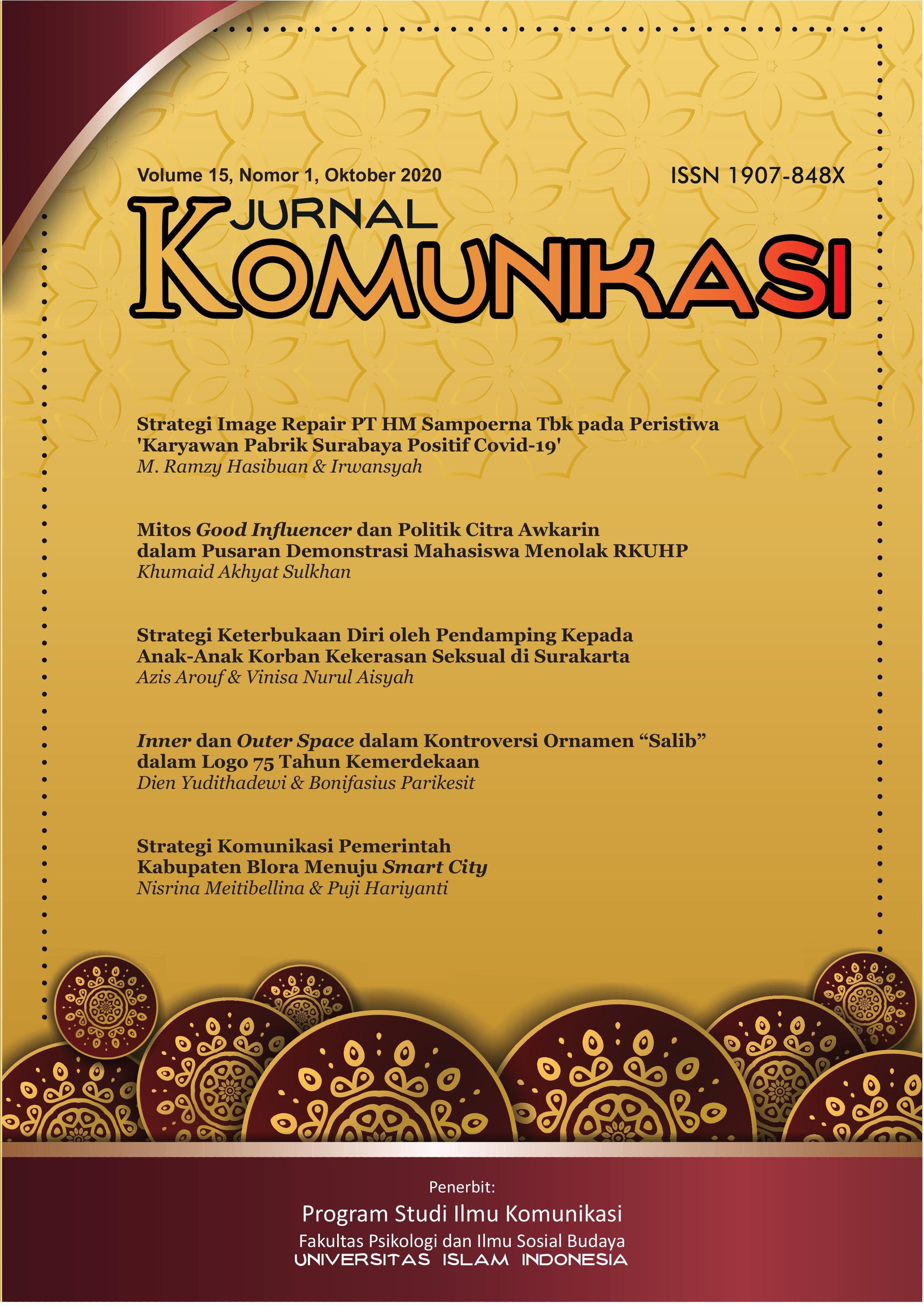Main Article Content
Abstract
This paper discusses how Awkarin reproduces the myth of good influencers as part of her political image in the student action against the RKUHP on September 24, 2019. With the semiotic method developed by Roland Barthes, the author examines the meaning of denotation and connotation in Awkarin's Instagram photos that record her involvement in the action at Senayan. As a result, the authors found that Awkarin built the image of an influencer who cares about social and political issues and mobilizes all their potential to help the public. However, the myth of the good influencer Awkarin is problematic, because she only involves herself in issues that are popular in society without going into further detail
Keywords : Good Influencer, Politics of Image, Awkarin, Student Demonstration.
Article Details
Authors who publish with this journal agree to the following terms:
- Authors retain copyright and grant the journal right of first publication with the work simultaneously licensed under a Creative Commons Attribution License that allows others to share the work with an acknowledgement of the work's authorship and initial publication in this journal.
- Authors are able to enter into separate, additional contractual arrangements for the non-exclusive distribution of the journal's published version of the work (e.g., post it to an institutional repository or publish it in a book), with an acknowledgement of its initial publication in this journal.
- Authors are permitted and encouraged to post their work online (e.g., in institutional repositories or on their website) prior to and during the submission process, as it can lead to productive exchanges, as well as earlier and greater citation of published work (See The Effect of Open Access).
References
- Abidin, C. (2016). Abidin CVisibility labour: Engaging with influencers’ fashion brands and #OOTD advertorial campaigns on Instagram. Media International Australia, 161(1), 86–100.
- Barthes, R. (1977). Image, Music, Text. Fontana.
- Berger, A. A. (2010). Pengantar semiotika: Tanda-tanda dalam kebudayaan Kontemporer. Tiara Wacana.
- Budiman, K. (2011). Semiotika visual: Konsep, isu, Dan problem ikonisitas. Jalasutra.
- Debord, G. (2005). The Society of Spectacle. Rebel Press.
- Hutapea, D. N. (2019). Analisis Pengaruh Daya Tarik, Kepecayan, dan Keahlian Selebgram Terhadap Minat Pembelian di Media Sosial Instagram. Jurnal Mahasiswa FEB Universitas Brawijaya, 7(2), 1–19.
- Irfani, F. (2020). “Awkarin Penuh Dosa, Kalian Suci Apa Adanya.” https://tirto.id/awkarin-penuh-dosa-kalian-suci-apa-adanya-ejR7
- Kellner, D. (2009). Barrack Obama and Celebrity Spectacle. International Journal of Communication, 3(1), 715–741.
- Khamis, S., Ang, L., & Welling, R. (2016). . (2016). Self-branding, ‘micro-celebrity’ and the rise of social media influencers. Celebrity Studies, 8(2), 191–208.
- Lalancette, M., & Raynauld, V. (2017). The power of political image: Justin Trudeau, Instagram, and celebrity politics. American Behavioral Scientist, 63(7), 888–924.
- Mefita, S., & Yualinto, M. (2018). Fenomena Gaya Hidup Selebgram: Studi Fenomenologi Selebgram Awkarin. Interaksi Online, 6(4), 567–573.
- Mosco, V. (2009). The Political Economy of Communication (2nd ed.). SAGE Publications.
- Ritzer, G. (2003). Teori Sosial Postmodern (Penerj. Muhammad Taufiq). Kreasi Wacana.
- Senft, T. . (2008). Camgirls: celebrity and community in the age of social networks. Peter Lang.
- Sobur, A. (2009). Analisis Teks Media. Rosdakarya.
- Storey, J. (1994). Cultural Theory and Cultural Culture: A Reader. Harvest Heartsheav.
- Sukmadinata, N. S. (2005). Metode Penelitian Pendidikan. PT Remaja Rosdakarya.
- van Driel, L., & Dumitrica, D. (2020). Selling brands while staying “Authentic”: The professionalization of Instagram influencers. Convergence: The International Journal of Research into New Media Technologies, 135485652090213. https://doi.org/10.1177/1354856520902136
References
Abidin, C. (2016). Abidin CVisibility labour: Engaging with influencers’ fashion brands and #OOTD advertorial campaigns on Instagram. Media International Australia, 161(1), 86–100.
Barthes, R. (1977). Image, Music, Text. Fontana.
Berger, A. A. (2010). Pengantar semiotika: Tanda-tanda dalam kebudayaan Kontemporer. Tiara Wacana.
Budiman, K. (2011). Semiotika visual: Konsep, isu, Dan problem ikonisitas. Jalasutra.
Debord, G. (2005). The Society of Spectacle. Rebel Press.
Hutapea, D. N. (2019). Analisis Pengaruh Daya Tarik, Kepecayan, dan Keahlian Selebgram Terhadap Minat Pembelian di Media Sosial Instagram. Jurnal Mahasiswa FEB Universitas Brawijaya, 7(2), 1–19.
Irfani, F. (2020). “Awkarin Penuh Dosa, Kalian Suci Apa Adanya.” https://tirto.id/awkarin-penuh-dosa-kalian-suci-apa-adanya-ejR7
Kellner, D. (2009). Barrack Obama and Celebrity Spectacle. International Journal of Communication, 3(1), 715–741.
Khamis, S., Ang, L., & Welling, R. (2016). . (2016). Self-branding, ‘micro-celebrity’ and the rise of social media influencers. Celebrity Studies, 8(2), 191–208.
Lalancette, M., & Raynauld, V. (2017). The power of political image: Justin Trudeau, Instagram, and celebrity politics. American Behavioral Scientist, 63(7), 888–924.
Mefita, S., & Yualinto, M. (2018). Fenomena Gaya Hidup Selebgram: Studi Fenomenologi Selebgram Awkarin. Interaksi Online, 6(4), 567–573.
Mosco, V. (2009). The Political Economy of Communication (2nd ed.). SAGE Publications.
Ritzer, G. (2003). Teori Sosial Postmodern (Penerj. Muhammad Taufiq). Kreasi Wacana.
Senft, T. . (2008). Camgirls: celebrity and community in the age of social networks. Peter Lang.
Sobur, A. (2009). Analisis Teks Media. Rosdakarya.
Storey, J. (1994). Cultural Theory and Cultural Culture: A Reader. Harvest Heartsheav.
Sukmadinata, N. S. (2005). Metode Penelitian Pendidikan. PT Remaja Rosdakarya.
van Driel, L., & Dumitrica, D. (2020). Selling brands while staying “Authentic”: The professionalization of Instagram influencers. Convergence: The International Journal of Research into New Media Technologies, 135485652090213. https://doi.org/10.1177/1354856520902136




